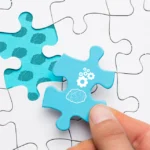
Table of Contents
In my previous article, I talked about the types and differences of ADHD. In this article, I will talk about the symptoms that psychiatrists pay attention to diagnosis of ADHD. Of course, they do not only look at these effects, but I think it will be useful to increase your awareness.
I want to emphasise that I am not trained in psychology or psychiatry. The information in this content is only the comments I have made based on my own experiences as an individual with ADHD as a result of the research I have done. For this reason, please note that I share this content only to raise awareness. If the topics and symptoms mentioned in this content are familiar to you, please consult a specialist first instead of diagnosing ADHD yourself.
How is ADHD Diagnosed?
In order to be diagnosed with ADHD according to the DSM-5 diagnostic criteria, certain symptoms must have started in childhood. Two main symptom groups are evaluated in the diagnosis of ADHD: Attention deficit and hyperactivity/impulsivity. In order to be diagnosed, the symptoms must persist for at least six months, affect the quality of life of the individual, and occur in two or more settings (e.g. home and school).
Important: These symptoms must have a serious impact on the individual’s life. As most people who do not have ADHD do when they hear them; It should not be confused with conditions such as normal distraction, and forgetfulness, which may be caused by fatigue/stress or experienced only for a short time.
What is DSM 5, and what does it stand for?
DSM is known as ‘The Diagnostic and Statistical Manual of Mental Disorders’. The DSM 5 study includes studies within the scope of reducing the comorbidities encountered in multiple diseases by being compatible with the clinical appearance of the diseases.
Attention Deficit and ADHD Diagnosis
One of the most common problems in individuals diagnosed with ADHD is attention deficit. This condition can create many difficulties in daily life. However, the attention deficit of individuals with ADHD actually only becomes apparent in routine, uninteresting subjects. On the other hand, when they focus on a subject that interests them, they enter a mental state called ‘hyperfocus’. Hyperfocus is a state of such deep focus that one can become indifferent to all environmental stimuli. For example, an individual with ADHD may not realise that there is a fire in the house while painting. This is similar to the way children with ADHD pay so much attention while playing that they do not even hear the sounds coming from outside.
Symptoms of Attention Deficit:
1. Lack of Attention to Detail
Individuals with ADHD often have difficulty paying attention to details and this can lead to careless work-related errors. However, this lack of attention only occurs in subjects that do not interest them and have become routine. Tasks that do interest them can create a completely different mental focus for them.
2. Inability to concentrate on tasks
Individuals with ADHD often have difficulty concentrating on tasks. This is especially evident in routine and boring tasks. However, they can switch to a hyperfocus state on a task that interests them. On the one hand, this is a powerful advantage, but on the other hand, it can lead to indifference to the world around them. At this extreme, they can become insensitive to urgent external stimuli.
3. Does not seem to listen
A person with ADHD may often appear not to listen when spoken to directly. This is because what the other person says reminds him or her of something else in his or her mind, or because he or she is constantly repeating what he or she wants to say so as not to forget it. This is not actually due to inattention but to mental preoccupation.
4. Failure to Fulfil Instructions
Individuals with ADHD often have difficulty following instructions and are often unable to complete schoolwork or household chores. However, this is only observed with routine tasks. When a task they have started becomes boring, their motivation drops rapidly and they tend to leave things unfinished.
5. Difficulty in Organising Tasks and Activities
Individuals with ADHD may find it difficult to organise tasks and activities. This becomes particularly evident when it is necessary to cope with a large number of tasks at once.
6. Avoidance of Work Requiring Mental Effort
Individuals with ADHD may tend to avoid tasks that require mental effort for a long time. This is because the stimuli around them can easily distract them and it becomes difficult for them to focus. This can create a constant feeling of discomfort and lead them to avoid such tasks over time.
7. Losing Necessary Items
Individuals with ADHD may often lose items that are necessary for tasks. This occurs as a result of a lack of attention and difficulty with organisation.
8. Easy Distraction
The attention of individuals with ADHD can be very easily distracted by environmental stimuli. This can create a constant challenge for them in everyday life and make the process of fulfilling all kinds of tasks more complicated.
9. Forgetfulness to Daily Activities
Individuals with ADHD may experience frequent forgetfulness in daily activities. This forgetfulness is often more pronounced in subjects that do not interest them and may result in important tasks not being done on time.
Hyperactivity/Impulsivity and ADHD diagnosis:
Individuals diagnosed with ADHD struggle not only with attention deficit but also with other difficulties such as hyperactivity and impulsivity. These traits can create major obstacles in individuals’ daily lives, social interactions, and work lives. Hyperactivity often occurs when a person feels the need to move non-stop. Impulsivity, on the other hand, involves acting on impulse, without thinking.
Symptoms of Hyperactivity/Impulsivity:
10. Constantly Fidgeting Hands or Feet
Individuals with ADHD often find it difficult to move their hands or feet or to fidget in a sitting position. This manifests itself as an impulse that keeps them in constant motion. This mobility of the people around them can sometimes be disturbing, but this behaviour is a natural part of ADHD and is an unconscious attempt to calm down.
11. Getting up from seats when not authorised
Individuals with ADHD, especially when bored or unable to focus, often get out of their seats and move around when not allowed to do so. This is an indication that it is difficult for them to cope with immobility and often becomes noticeable in public.
12. Running or Climbing in Inappropriate Situations
Hyperactivity can manifest itself in individuals with ADHD through behaviours such as running or climbing in inappropriate situations. This may be more pronounced among children, but adults may also have difficulty displaying appropriate behaviour in social situations. However, often in adults, due to environmental factors and societal pressures, this hyperactivity develops into a symptom called thought confusion and brain fog, leading to severe mental fatigue.
13. Inability to Participate Quietly in Leisure Activities
Individuals with ADHD often find it difficult to participate quietly in leisure activities. Even when others are resting or engaged in quiet activities, the desire to act for them dominates and this can lead to social disharmony.
In adulthood, this symptom causes effects such as not knowing what to do or not being able to rest during leave, holiday or free time. The adult experiencing such an effect may exhibit a workaholic profile by working on his/her days off/holidays because he/she does not know what to do.
14. Being in constant motion as if ‘driven by a motor’
Individuals with ADHD are in constant motion in a way that is described as ‘motor-like’. This is a way of expressing their inner energy. This may also be evident in an environment where they sit impatiently in their surroundings. The need for constant movement can sometimes be misunderstood in social settings.
15. Excessive Talking
Individuals with ADHD often talk excessively. They may want to tell everything about themselves or they may try to explain the subject in a long and complex way. In this process, they may forget what they are going to say and the subject may get distracted. They may lose the integrity of the subject because some of their thoughts may quickly shift to another point.
16. Impulsive Responses
Individuals with ADHD usually give answers without thinking. They say the first thing that comes to their mind without checking whether the environment is appropriate or not. This impulsiveness can sometimes lead to misunderstandings or social awkwardness. However, this is only due to their tendency to act impulsively and is not a personal intention.
17. Difficulty Waiting for a Queue
Individuals with ADHD may experience great restlessness in any queue where they have to wait for a long time, such as for a speech or a bus queue. Their impatience makes it difficult for them to tolerate the long time required to wait their turn. This can sometimes characterise them as ‘impatient’ in public.
18. Interrupting and Interfering
Individuals with ADHD may interrupt or intervene with others during conversations. This is because they interrupt others’ sentences in order not to forget what they said while they are speaking. Although this impulsive behaviour sometimes causes the other party to be disturbed, it usually occurs immediately after the conversation due to the influence of their mental processes.
The above items have been prepared to raise awareness about the attention deficit and hyperactivity/impulsivity dimension of ADHD and how this situation affects an individual with ADHD in all areas of life. Please remember that by increasing your awareness of these characteristics, these symptoms can be made more manageable with appropriate strategies by getting support from a psychologist, psychiatrist or ADHD coach.
ADHD also offers individuals the opportunity to explore their potential by giving them a different and creative perspective. Therefore, being more understanding of the individuals around us with ADHD can help them to emphasise their strengths.


